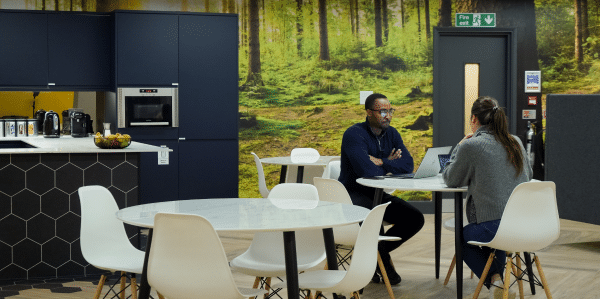Technology is galloping ahead. Our phones and homes are Smart and so too is the office where innovation is transforming the way we work. Smart technology can speed up productivity by streamlining processes and creating efficient, sustainable and attractive contemporary workplaces.
Demand for smart office technology was driven by the pandemic in 2020 when lockdown spawned the concept of hybrid and remote work. It came into its own because the technology enables collaboration between remote workers and their colleagues on site.
While there are many advantages to be gained from smart offices, there are downsides too and the best solutions are those which get the balance right.
Advantages of smart office tech
The following are known advantages of smart tech in the workplace:
- Increased productivity – by utilising AI and technology to digitise tasks, especially repetitive ones that were previously done manually, time is freed so that workers can concentrate on areas that most benefit the business.
- Energy efficiency – sustainability is at the forefront of smart office technology. With smart heating, lighting, and air cooling systems, modern offices can be more planet friendly than ever.
- Staff well-being – smart technology can also be used to aid staff well-being. Ergonomic furniture, smart lighting, and efficient heating control can make a world of difference to office workers.
- Cost saving – smart technology encourages organisations to look at their physical footprint and work out how much office space they actually need. By reducing it, they’ll save on rent and maintenance costs. The streamlining of manual processes also reduces labour costs. Energy efficiency measures can also lower utility bills.
What are the disadvantages of smart office technology?
While the advantages are many, there are also some disadvantages of smart office technology, namely:
- Costs – smart technology can be expensive and there will be initial outlay costs as well as the expense of ongoing maintenance. It pays to consider the return on investment before you commit to adopting smart technology. If executed properly, one of the side effects of smart technology should be a reduction in overall costs.
- Over-reliance on technology – smart offices rely heavily on technology, meaning that glitches, cyber attacks, and other problems, can be catastrophic. For this reason, any organisation that wants to rely heavily on smart tech, must have watertight contingency plans. Smart offices can now use technology to tighten access and reduce the chances of data security breaches.
- Workforce resistance – any employees who’ve been with an organisation for a long time and are used to a certain way of working, may resist technological changes. They might fear that it could lead to the eradication of their jobs or worry that it will be too challenging for them to embrace. Make sure you consult your workforce regarding any technological changes and ensure they receive training and support throughout.
Best ways to create a smart office
When creating a smart office, planning and forethought are essential. Here’s a guide to how best to tackle it:
- Detailed planning – list the objectives and requirements of the company and consider how smart technology can help deliver the right results. Any smart office plan has to align with the organisation’s goals.
- Involve employees – make sure that your employees are involved from the beginning. Springing technological changes on them without forewarning could cause unrest. Answer their concerns and make sure you provide adequate training so that all staff members feel confident with the new smart office features.
- Choose scalable technologies – your business will change and grow with time and for that reason, flexibility and scalable tech are a must.
- Make comfort a priority – let your staff know that their comfort is one of your main priorities and where possible, seek their input so that you can customise your smart workplace to suit their needs. Sound proofing, ergonomic furniture, adjustable lighting and easy-to-use temperature controls all make an office environment more pleasant for those who inhabit it.
Should you opt for a smart workplace?
The trend for smart workplaces will only grow and there may come a time, in the not too distant future, where people consider hi-tech office environments as a reason for choosing one company over another when they seek to change roles.
The advantages, such as increased productivity, streamlined processes and sustainability far outweigh any of the disadvantages, which can be overcome with careful planning and by making sure that people are at the heart of the transformation process.

Frank has worked in the serviced office industry for 25 years with a role in
operations were service is key. Workplace service is important and can make
a great difference to your employees.
You may also like...
Contact Us
Speak to one of our team today who would
be delighted to provide you with information,
discuss your requirements or book in a
viewing to see the office space for yourself.


